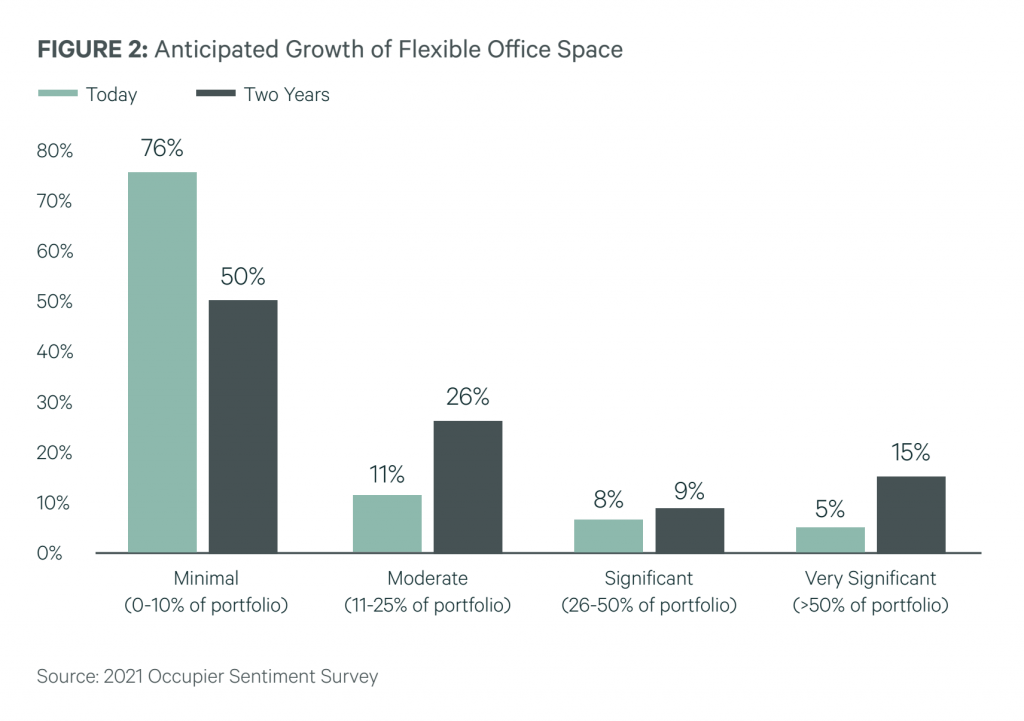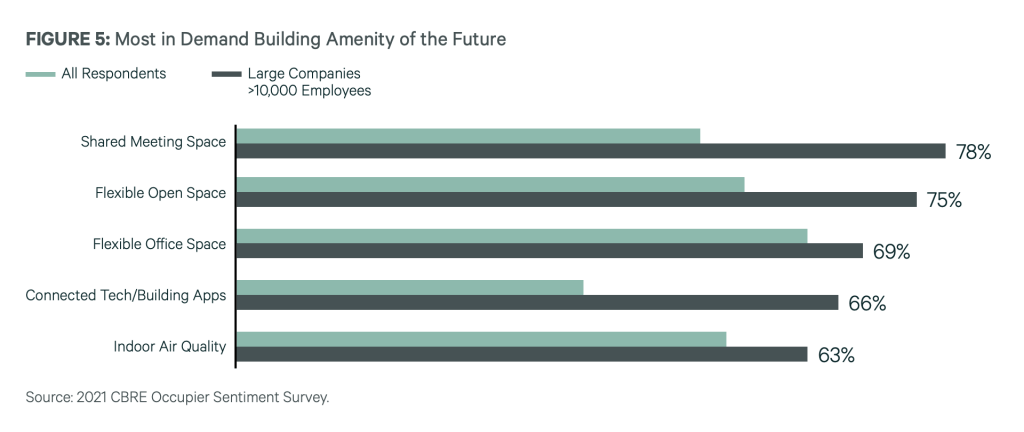The pandemic accelerated several business trends–the shift to remote work, digital transformation, and the need for agility. One of the major challenges companies of all sizes are facing today is determining how they will utilize space moving forward.
The good news is that companies are aware that changes need to be made. A recent CBRE report found that enterprise occupiers are already working on refining their portfolio and workplace strategies.
This is a great first step. Unfortunately, for many organizations, the second, third, and remaining steps are not as clearly laid out. At least not yet.

The shift to hybrid work and its impact on real estate
As more companies shift to a hybrid first work model, there is a pressing need to create and implement more efficient real estate structures.
The most efficient solution for many organizations is to embrace flexible workspace solutions. In fact, CBRE’s Occupier Sentiment Survey found that nearly one-quarter of respondents report having more than 10% of their real estate portfolios in flexible office space.
What’s more telling, however, is that more than half of respondents expect to have flexible space account for more than 10% of their real estate portfolios in the next two years.
Why?
Because flexible workspace solutions can enable companies to better respond to changing employer-employee dynamics, and iterate if necessary. According to CBRE, flexible space can help organizations achieve cost efficiencies and create engagement within their space when employees choose to come into the office.
Despite flexible space emerging as a natural solution, questions and challenges about how companies can best leverage it remain a barrier to more widespread adoption.

Challenges and Opportunities
According to CBRE, lack of user experience with flexible workspace solutions is one of the leading barriers of entry to flex space, along with privacy requirements.
“Although many occupiers would like to incorporate flexible office space into agile real estate strategies, they often are unsure how to execute it.”
At Industrious, we have seen companies leverage our flexible workspace solutions in two primary ways:
1. Core + flex
Core + flex allows companies to have a mix of term lengths within a flexible workspace, which allows an organization to book shared spaces as an overflow solution when needed. Being part of a flexible workspace also provides employees with access to shared facilities like kitchen and conference rooms.
With a core + flex approach, companies can reduce their real estate footprint by as much as 50%, while still being able to accommodate for uncertain headcount and usage.
2. Hub-and-spoke
A hub-and-spoke real estate strategy allows companies to have a main hub (HQ) and different hubs spread out across different regions to better support hybrid work arrangements and distributed teams.
Companies are leveraging this approach for a few main reasons, (1) to tap into new talent markets, (2) to drive collaboration among distributed teams, and (3) to respond to overflow and uncertainty in headcount.
Both the core + flex and hub-and-spoke approaches reduce an organization’s risk of being locked into long-term contracts that make it challenging to adapt to changing patterns–from headcount and how often employees come in during the week, to how employees are using the space and what types of environments they are tapping into most.
While lack of user experience is the main barrier to adoption, privacy requirements are also deterring companies from fully embracing flex.
Flexible workspaces are, by nature, shared workspaces; which raises many security concerns for large enterprises, primarily network and access security.
At Industrious we saw enterprise desk sales increase by over 150% in Q3 2021 vs our pre-pandemic levels.
One of the reasons we have been able to grow our enterprise membership is because we understand and can accommodate privacy requirements with our dedicated suites offering. Our landlord-partnership based business model also allows us to work hand in hand with landlords to ensure that we can cater to large occupier demands and requirements, from private access points to private IT networks.
The way we work has changed and real estate is quickly shifting from being a static product to a service that occupiers hire on a flexible basis to better accommodate ever-changing business needs, while reducing risk and expenses.